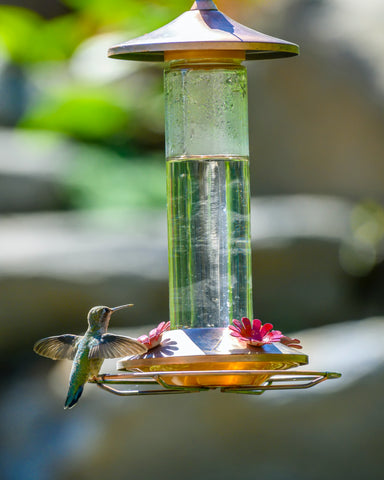Creating a Hummingbird Garden: Plant Selection and Tips
In this blog post you'll learn tips and tricks on how to create a hummingbird garden, how to select the best plants and flowers, and much more.
Imagine your garden coming alive with the mesmerizing sight of tiny, colorful creatures darting through the air with grace and speed. Hummingbirds, with their iridescent feathers and distinctive hovering abilities, can bring an enchanting ambiance to any outdoor space.
To attract these charming little birds and support their well-being, creating a hummingbird-friendly garden is a rewarding endeavor. In this blog post, we will explore the essential steps for designing a hummingbird haven through thoughtful plant selection and practical tips.
Here is one of our best selling hummingbird feeders.
Understanding Hummingbird Needs
Before we delve into the specifics of plant selection, it's vital to understand the unique needs of hummingbirds. These tiny birds are nectarivores, relying heavily on nectar for their diet. To support their energy-demanding lifestyle, they require a regular supply of nectar-rich flowers. Moreover, hummingbirds also feed on insects and spiders to supplement their diet with essential proteins and nutrients.
Looking to see a hummingbird in your garden all the time? Check out this hummingbird stake.
To attract hummingbirds to your garden, you must provide them with the following elements:
-
Abundant Nectar Sources: Planting a variety of nectar-rich flowers ensures a steady food supply for hummingbirds. The more diverse your flower selection, the more likely you are to attract a broader range of hummingbird species.

-
Shelter and Safety: Hummingbirds are wary creatures and need a sense of security while feeding. Providing them with perches, trees, and shrubs gives them a place to rest, hide from predators, and even build nests.
-
Water Source: Like all creatures, hummingbirds need access to water for drinking and bathing. Consider adding a birdbath or small shallow fountain to your garden to cater to their hydration needs.
-
Avoid Pesticides: Hummingbirds are sensitive to chemicals, so refrain from using pesticides or herbicides that could harm them or their food sources.
Selecting Hummingbird-Friendly Plants
Choosing the right plants is the cornerstone of creating a hummingbird-friendly garden. Opt for flowers with tubular shapes and bright colors, as these are the ones most attractive to hummingbirds. Here are some popular hummingbird-friendly plants to consider:
-
Bee Balm (Monarda): With its vibrant red, pink, or purple flowers, bee balm is a favorite of both hummingbirds and bees. Its delightful fragrance adds another layer of allure to your garden.
-
Trumpet Vine (Campsis radicans): As the name suggests, the trumpet vine produces long, tubular orange or red flowers that are irresistible to hummingbirds. Be cautious, though, as this vine can be vigorous and may require some pruning to keep it in check.
-
Salvia (Salvia spp.): Salvia comes in various colors and sizes, offering an abundance of nectar for hummingbirds. It's a low-maintenance plant that thrives in many climates.
-
Columbine (Aquilegia): This delicate, bell-shaped flower is a hummingbird favorite. It comes in various colors and adds a touch of elegance to any garden.
-
Lupine (Lupinus): Hummingbirds are drawn to the tall spikes of lupine flowers, which can add a vertical dimension to your garden while providing ample nectar.
-
Penstemon (Penstemon spp.): Also known as beardtongue, penstemon produces tubular flowers in a wide range of colors, making it a versatile choice for attracting hummingbirds.
-
Fuchsia (Fuchsia spp.): Fuchsia's pendulous, tube-shaped flowers in shades of pink and purple are practically designed for hummingbirds to feed on.
Designing Your Hummingbird Haven
Creating a hummingbird-friendly garden involves more than just planting the right flowers. It's about crafting a space that appeals to these delightful creatures and encourages their presence. Consider the following tips to make your garden a true hummingbird haven:
-
Group Plants Together: Planting flowers in clusters can create a more appealing target for hummingbirds. It allows them to visit multiple blooms in one spot, saving energy as they forage.
-
Add Bird Feeders: While planting nectar-rich flowers is crucial, supplementing their diet with hummingbird feeders is an excellent idea, especially during periods when natural nectar sources may be scarce.
 * Find this feeder here.
* Find this feeder here. -
Provide Shelter: Hummingbirds need places to rest, preen, and hide from predators. Planting trees, shrubs, and climbers can provide the perfect sanctuary for them.
-
Include Native Plants: Native plants are well-adapted to the local environment and are more likely to attract native hummingbird species.
-
Create Colorful Borders: Hummingbirds are naturally drawn to vibrant colors like red, orange, and pink. Planting colorful borders will attract their attention and make your garden a visual delight.
-
Offer Fresh Water: A shallow birdbath or a small water feature with a gentle trickle of water can serve as a vital water source for hummingbirds.
Don't forget the ant moat.
Conclusion
Designing a hummingbird-friendly garden is an enriching experience that brings you closer to nature's marvels. By understanding their needs, selecting the right plants, and providing a nurturing environment, you can transform your garden into a haven for these delightful avian visitors.
Remember to be patient, as it may take some time for hummingbirds to discover and trust your garden as a reliable source of nectar. With time and effort, you'll be rewarded with the joy of watching these enchanting creatures grace your garden with their presence.

